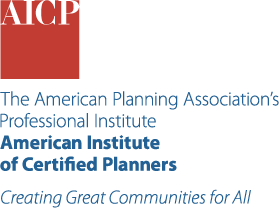Looking for education on this topic?
Check Out Our Passport Courses
Passport is your ticket to the training, experiences, and connections that will take you where you want to go in your planning career. Subscribe for unlimited access for one year to APA's extensive learning library of solution-oriented content facilitated by planners, for planners.
-
Forging Neighborhoods for all Generations
May 2016by: Mildred Warner, Amanda Micklow, AICP, Melissa StantonThis recorded webinar introduces multigenerational planning as an effective approach to creating age-friendly communities. -
Age-Friendly Communities: Creating a Custom Needs Assessment
December 2015by: Arlene Groh, John LewisThis recorded webinar explains how to create a custom needs assessment to plan for age-friendly communities and highlights Waterloo, Ontario as a case study. -
Creating Aging-Friendly Communities Conference
February/March 2008by: Center for the Advanced Study of Aging ServicesThis recorded conference features a series of presentations from thought leaders on the topic of age-friendly communities. -
Child Care
March 2011by: Kristen Anderson, Mildred Warner, Libby TylerThis recorded webinar highlights the importance of childcare and early education to the social and economic well-being of a community. -
Accessibility and Age-Friendly Communities - Strengthening Local Impact
March 2019by: Alfred Spencer, Cheryl Dillon, Sarah WebsterThis recorded webinar defines what an age-friendly community is and introduces how the concept of accessibility can be applied to planning efforts. -
Age Friendly Communities & Rural America Transportation Challenge
Age Friendly Webinar Series, January 2018by: Laura Mason, Andrew Levack, Amy St PeterThis recorded webinar explores the connections between transportation and aging-in-place in a rural context. -
WHO/IFA Webinar 11 - An Introduction: The Decade of Health Ageing
May 2019by: Mary ManandharThis recorded webinar introduces the World Health Organization’s (WHO) Decade of Healthy Ageing (2020 – 2030) and shares how stakeholders from public and private agencies can work towards achieving the project’s objectives. -
Ontario AFC Interactive Maps
2018by: Seniors Health Knowledge NetworkThese two interactive maps share the progress of the age-friendly communities movement in Ontario, Canada. -
The Aging-Friendly Agenda Part 1
March 2012by: Kathy Sykes, Katherine Clark, AICP, Allen GlicksmanThis recorded webinar discusses Age-Friendly Philadelphia, a research, planning, and policy agenda based on the EPA’s Aging Initiative model. -
Age Strong Roundtable - Full Discussion
November 2015by: Emily Allen, Catherine Godschalk, Scott SporteThis video includes a roundtable discussion about Age Strong, AARP Foundation’s social investment initiative designed to support enterprises that provide services to low-income or otherwise vulnerable older adults. -
The Future of Age-Friendly Communities - Research on Aging
Stein Institute for Research on Aging, November 2015by: Laurence WeinsteinThis recorded lecture defines and discusses the dual concepts of livable communities and livable homes. -
WHO/IFA Webinar 1 - Establishing Age Friendly Environments
February 2017by: Alana OfficerThis recorded webinar introduces the World Health Organization’s Global Network of Age-Friendly Cities & Communities. -
WHO/IFA Webinar 8 - Age-Friendly Europe: Good Practices and Next Steps
May 2018by: Manfred HuberThis recorded webinar tracks age-friendly initiatives in Europe and highlights the benefits of collaboration. -
A Place for Everyone: Age Friendly Communities
March 2010by: Gordon Price, Lewis Villegas, Elaine GallagherThis video includes a roundtable discussion with thought leaders on aging from Canada on how to create age-friendly communities. -
Place Matters: A Two-Generation Approach to Housing
December 2018by: Susan Popkin, Elsa Falkenburger, Sarah HaightThis guide shares how housing organizations can better serve low-income families with children through a two-generation (2Gen) approach. -
The Maine Guide: Building Livable, Age-Friendly Communities
September 2016by: Lori Parham, Patricia Oh, Andrea CooperThis guide draws from age-friendly resources by the World Health Organization and AARP to support local age-friendly community efforts in small and rural communities in Maine. -
Responding to Child Care Facilities: A Practical Guide for City & County Planners
2007by: Gerry Raycraft, Pam Schmidr, Ed BolenThis guide is designed for city and county planners to better understand how the childcare system is operated and regulated in California. -
Organizing your Community for Aging in Place
2018by: National Aging in Place CouncilThis guide explains how NAIPC chapters can mobilize community stakeholders and resources to meet the needs of older adults. -
Planning for Aging-Friendly Communities
2019by: University of DelawareThis guide includes links to descriptions of age-friendly concepts and strategies for local officials in Delaware. -
Jemez Springs, NM, Comprehensive Plan
Adopted August 2015The village’s comprehensive starts the conversation of creating an age-friendly, lifelong, and livable community. -
Louisville/Jefferson County, KY, Age-Friendly Louisville Strategic Plan
Adopted 2019This functional plan discusses at length the history and methodology of the planning process, including how the plan engages with the area’s comprehensive plan. -
Berkeley, CA, Age-Friendly Berkeley Action Plan
Adopted December 2018This functional plan prioritizes housing and economic security, transportation and mobility, health and wellness, and social participation and civic engagement to create an age-friendly community. -
District of Columbia, Age-Friendly DC
Adopted 2018This functional plan updates Washington DC’s continued effort to become an age-friendly community. -
Biddeford, ME, Age-Friendly Biddeford
Adopted February 2019This functional plan uses the results of a community survey to propose several age-friendly interventions. -
Boston, MA, Age-Friendly Boston Action Plan
Adopted 2017This functional plan includes age-friendly recommendations organized by the WHO’s eight domains of livability that address topics like dementia, economic insecurity, and social isolation. -
Chula Vista, CA, Creating an Age-Friendly City
Adopted July 2018This functional plan includes a robust discussion of community involvement that intentionally includes youth and older adults. -
West Sacramento, CA, Age-Friendly Action Plan
Adopted 2017This functional plan grounds its work and recommendations in the experiences of older adults from the community. -
Matthews, NC, 2018 Age-Friendly Community Action Plan
Adopted 2018This functional plan proposes age-friendly interventions related to housing, outdoor spaces and buildings, transportation, and community support and health services. -
Minneapolis, MN, Minneapolis for a Lifetime
Adopted November 2016This functional plan adopts housing, transportation, and health and wellness as its three priority areas. -
I Need You, You Need Me: The Young, the Old, and What We Can Achieve Together
May 2017by: Olivia GentileThis report argues for the use of intergenerational programs to combat age-segregation. -
Cities and Ageing
GCIF Policy Snapshot 2, September 2013This report considers the impact that rapid urbanization and aging will have on cities and introduces the Age Friendly City Policy, Planning & Design framework and its indicators. -
Portland, ME, Age Friendly Community Work Plan
2016This functional plan proposes goals, objectives, and actions related to housing, transportation, and health and community services/communication. -
Multi-Generational Community Planning: Linking the Needs of Children and Older Adults
April 2010by: Mildred Warner, George Homsy, AICP, Esther GreenhouseThis briefing paper shows that multigenerational planning is the most effective way to mobilize resources and meet the needs of youth and older adults. -
Expanding Lifestyle Amenities for Families: Parks and Recreation
April 2009by: Kathleen HooverThis briefing paper discusses how parks can be activated to address childhood development, neighborhood safety, public health, and arts and cultural events. -
The Case for Age-Friendly Communities
February 2016by: Margaret Neal, Alan DeLaTorreThis report argues that creating an age-friendly community makes economic and social sense. -
Where We Live: Communities for All Ages
Where We Live 3, 2018by: Nancy LeaMond, Melissa StantonThis report highlights over 100 local projects that are working to enhance livability for all ages across the country. -
Administration for Community Living: Data and Research
Updated September 2017This web page includes data and research on aging & disability, including growth projections and key indicators of well-being. -
Safe Routes for Older Adults
April 2018by: Tracy McMillan, Ana Lopez, Jill CooperThis guide belongs to the Active Transportation and Age-Friendly Communities collections. -
Walk Audit Tool Kit
2016by: AARPThis guide belongs to the Active Transportation and Age-Friendly Communities collections. -
Maricopa County, AZ, Zoning Ordinance
Updated May 2017These regulations belong to the Group Housing, Home Occupations, and Solar Energy collections. -
St. Paul, MN, Saint Paul for All
Approved March 2019This comprehensive plan belongs to the Historic Preservation and Social Equity collections. -
Cities in the Time of COVID-19: How Do We Respond to Anti-Black Racism in Urbanist Practices and Conversations?
June 2020This video contains a conversation between five Black urbanists discussing their experience with anti-Blackness, racism, and other issues in the field of urbanism. -
Advocacy and Pluralism in Planning
Journal of the American Institute of Planners, 31(4): 331-338, 1965by: Paul DavidoffThis JAPA article urges planners to engage in political processes, like advocates, and to facilitate the creation and presentation of plural plans. -
Local Governments, Social Equity, and Sustainable Communities: Advancing Social Equity Goals to Achieve Sustainability
2014by: James Svara, Tanya Watt, Katherine TakaiThis report uses data from a national survey to assess whether local governments are incorporating social equity into their sustainability efforts. -
Resources for Creating Healthy, Sustainable, and Equitable Communities
Updated 2019This clearinghouse lists environmental justice resources by topic, including technical assistance and funding opportunities. -
Program for Environmental and Regional Equity: Publications
Updated 2019This clearinghouse organizes resources by research area, including Environmental Justice and Climate Equity, Inclusive Economics and Regional Equity, and Governing Power and Social Movement Building. -
City and Metropolitan Inequality on the Rise, Driven By Declining Incomes
Brookings, January 2016by: Natalie Holmes, Alan BerubeThis article unpacks the trend of growing income inequality and its consequences. -
Community Commons: Equity
Updated 2019This clearinghouse shares tools and resources related to health equity from local, regional, and federal sources. -
The Expanding Transportation Network Company 'Equity Gap': Adverse Impacts on Passengers with Disabilities, Underserved Communities, the Environment & the On-Demand Workforce
2016by: Matthew DausThis report lays out the equity concerns of transportation network companies, like Uber and Lyft. -
Out of Reach 2016: No Refuge for Low Income Renters
2016by: Diane Yentel, Andrew Aurand, Dan EmmanuelThis report investigates the housing affordability crisis and shares data, including housing wage, housing costs, area median income, and renter households, for each state.


